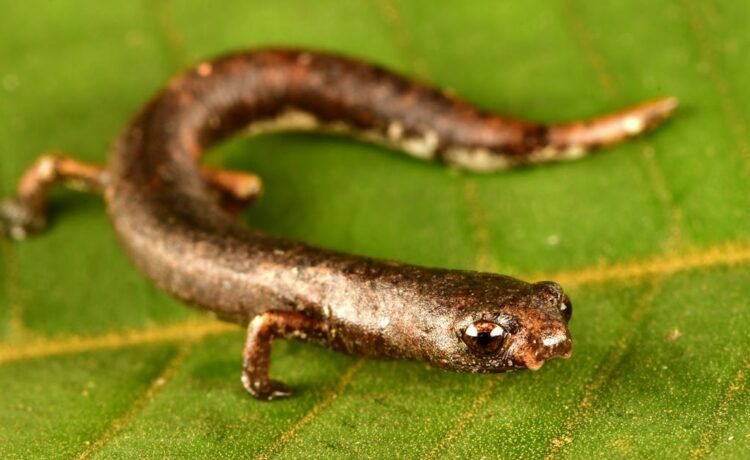Editor’s note: From “blue carbon” to “ecosystem services,” environmental jargon is everywhere. Conservation International looks to make sense of it in an occasional explainer series we’re calling “What on Earth?“
In this installment, we explore eDNA, a wildlife monitoring tool that is changing the way we study the natural world.
I keep seeing this thing called “eDNA” in science articles. What is it?
Ok, so, eDNA is basically “CSI: Nature Edition.”
Just as humans shed hair, skin cells and sweat, animals are constantly leaving tiny traces of themselves in their environment — in the water, snow, soil or even the air. These microscopic breadcrumbs contain bits of genetic material: DNA.
Scientists call this “environmental DNA,” or eDNA for short. By collecting samples from a pond, a river or possibly even a cloud of dust, researchers can analyze the DNA fragments left behind to figure out what species have been there — even if they never saw them.

A stream in the Alto Mayo Protected Forest where scientists took samples to test for eDNA, which helps them rapidly detect species that are difficult to observe directly.
So, scientists don’t need to spot an animal to know that it’s there?
That’s what makes eDNA so cool. A scientist can scoop up a bit of pond water, analyze it in the lab, and figure out which critters have been hanging out there.
“eDNA is great for finding species that are rare, secretive or live in places people can’t easily reach,” said Ali Swanson, who leads nature technology at Conservation International. “The technique works especially well in water, where DNA easily mixes and moves around — a single sample can give us a surprisingly rich snapshot of the broader watershed, including areas that would be tough to survey in person.”
What kinds of animals can you find with eDNA?
All kinds! Fish, amphibians, mammals, birds, insects — even microbes. A single sample can reveal hundreds of species. Scientists have even used eDNA to find endangered snow leopards, survey animals on the top of Mount Everest and detect deep-sea creatures no one’s ever seen in person.

Snow leopards, a notoriously difficult species to spot in the wild, have been detected with eDNA.
How about dinosaurs?
Sadly, there is no T. rex DNA in your backyard garden. eDNA breaks down pretty quickly in the environment — usually within days — so it’s great for detecting recent or current presence, not ancient history.
Ok, fine, no Jurassic Park — but it does sound like it can really help protect wildlife.
Absolutely. eDNA can provide solid scientific evidence that can help attract funding for conservation or inspire new protections for threatened ecosystems.
Take a real-world example from northern Peru: Researchers with Conservation International ventured into a part of the Alto Mayo forest that hardly any ecologists had studied before. Instead of trying to spot every animal in person, they collected water samples from rivers and streams and let eDNA do the detective work. It paid off — they detected DNA from 261 vertebrate species, many of them rare or hard to spot.
That discovery is now helping to shape a new ecological corridor that will connect Alto Mayo to other protected areas across the region — giving wildlife more room to roam.
So does this mean eDNA can replace other methods, like camera traps or field visits?
Not quite. eDNA is a powerful tool, but it works best alongside other methods. It’s great at telling you what species are present — but it’s still hard to say how many individuals there are, or exactly when they passed through. That’s where tools like camera traps, acoustic sensors and good old-fashioned fieldwork still play an important role.
“Every wildlife sensor, like species themselves, has a unique niche,” Swanson said. “Acoustic monitoring is great for finding birds or insects, camera traps are often ideal for larger mammals. eDNA, which excels at uncovering shy or rare critters, is part of a mosaic of tools that together reveal a more complete picture of an ecosystem.”
Any good examples?
Well, actually, that’s exactly what the team did in Alto Mayo. In addition to using eDNA, they also relied on traditional field surveys — like actually spotting animals or collecting specimens — to confirm their findings. And in doing so, they discovered species like a mouse that swims and a totally weird blob-headed fish that are entirely new to science — something eDNA can hint at but can’t confirm on its own.

A type of bristlemouth armored catfish, this “blob-headed” fish was discovered on a recent research expedition in the Alto Mayo Protected Forest.
I’m sold. When can I investigate my own back yard using eDNA?
It may be a while. Right now, most eDNA tools are still lab-based and require some serious gear and know-how. But scientists are working on making the process faster, cheaper and more portable.
Some early projects are already involving citizen scientists to help collect samples. And if you’ve ever used the Seek app to identify an interesting mushroom or submitted a photo to iNaturalist, you’re already part of a movement that’s crowdsourcing science.
Who knows, someday eDNA could be the next evolution — keeping tabs on biodiversity by simply filling a sample bottle on your next hike.
Will McCarry is a staff writer at Conservation International. Want to read more stories like this? Sign up for email updates. Also, please consider supporting our critical work.






Recent Comments